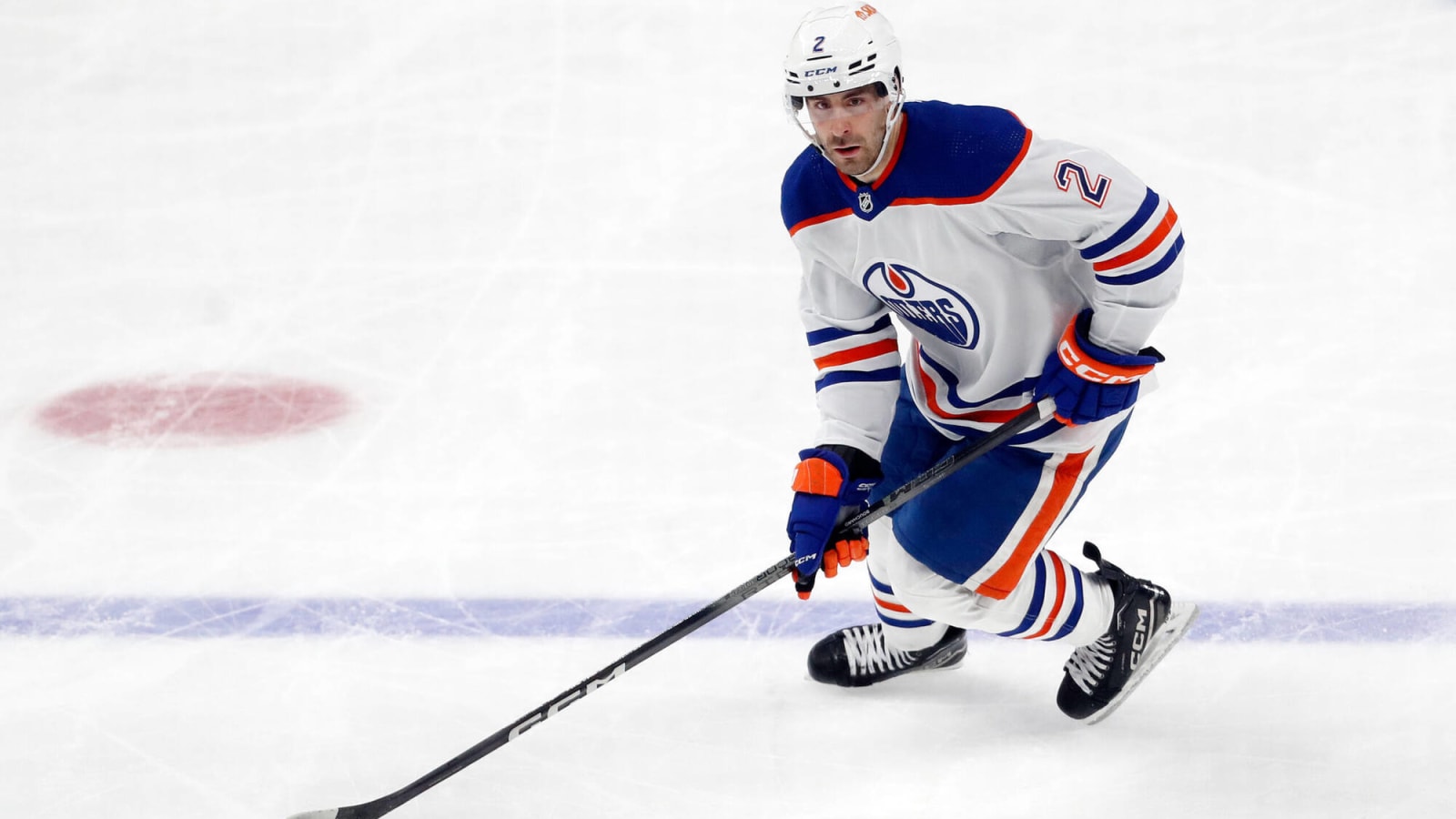
Evan Bouchard is having a phenomenal season. With 76 points in 72 games, Bouchard ranks fourth among all NHL defencemen in total points.
The underlying numbers are just as strong. At even strength, Bouchard has been on the ice for 87 goals for and 55 against, equating to an excellent +32 goal differential. That ranks fourth in the entire league and second among all defencemen, only behind Quinn Hughes. Bouchard also holds a fantastic 60 percent on-ice expected goal differential.
It’s not as if Bouchard has been playing in some sheltered role. He leads Edmonton’s defencemen in average TOI per game, and ranks first in total TOI against elite competition (per PuckIQ). Out of all NHL defencemen with a minimum of 100 minutes against elite opposition this season, Bouchard ranks second in relative DFF% (dangerous shot differential) against elites, only behind Adam Fox.
All-in-all, Bouchard’s results are superb, and he has formed a dominant defensive pairing alongside Mattias Ekholm. Bouchard could likely even obtain some Norris votes this season.
However, the subject of Bouchard’s overall impact remains somewhat polarizing, specifically regarding his defensive play.
Fans, media, and reporters alike can often be highly critical when Bouchard makes errors leading to a chance or goal against. This was evident in a recent example when Bouchard was beaten badly in the corner by Auston Matthews in a game against the Maple Leafs last weekend, leading to a goal against and some pretty hefty criticism and debate over his two-way impact.
Does Bouchard’s offence outweigh his defence? Is he the massive defensive liability that many of his detractors claim? In this piece, I would like to dive into these contentious questions and analyze his even-strength play in each of the offensive, neutral, and defensive zones.
This season, I have begun a manual stat tracking project for all Edmonton Oilers games alongside two other wonderful people to track stats known as microstats (a glossary explaining each stat we track is linked here). These stats are typically tracked by private companies and NHL teams and are not publicly available. There are three Oilers games in March that we have not yet finished tracking, but the sample remains highly accurate regardless. This project aims to obtain more detailed data to get a better understanding of a player’s impact.
Using on-ice stats, manually tracked microstats, and even videotape, here is an extensive analysis of Evan Bouchard’s even-strength impact in each of the three zones of the ice.
*All microstats via our tracking project, all other on-ice stats via EvolvingHockey, Natural Stat Trick, and PuckIQ unless stated otherwise
Offensive Zone
Firstly, there is no denying that Bouchard possesses a fantastic shot, the “Bouch Bomb.” Thus far, Evan Bouchard has 16 goals on the season, ranking fifth among all defencemen and just three behind Roman Josi for first place. Per NHL EDGE, Bouchard has taken a whopping 106 shots over 90+ miles per hour, more than any player in the entire league. A key aspect of Bouchard’s fantastic on-ice offensive metrics is his ability to consistently get hard, quality shots on net.
Bouchard is also a prominent passer in the offensive zone. This season, Bouchard leads Edmonton’s defencemen with 9.4 primary shot assists per 60, while the team average is 5.7. Bouchard is an excellent passer in the offensive zone, and excels at quickly moving the puck to linemates to generate scoring chances.
Even without McDavid on-ice at 5v5, Bouchard has been on-ice for 2.6 goals per hour and 3.1 expected goals per hour, while the rest of the team is at 1.9 goals and 2.7 expected goals per hour without McDavid. There is no doubt Bouchard has highly benefited from playing with the best player in the world, but he remains a highly skilled offensive asset either way.
While Bouchard can often be a polarizing player, the vast majority of people would agree his offensive skills are exceptional. I won’t dive too deep into those specific aspects.
Now, contrary to many people’s opinions, Bouchard’s 5-on-5 defensive impacts are actually quite good this season. Even though Bouchard regularly plays against top competition, the Oilers allow fewer shots, scoring chances, and high-danger chances per hour at 5v5 with him on ice.
There’s another aspect of Bouchard’s offensive zone play that is often underrated, and actually plays a major role in these defensive results; his ability to maintain and sustain possession.
In our tracking project, we track forecheck disruptions, defined as plays where a player pressures an opposition player into making turnovers and/or intercepts a pass/clearing attempt causing a turnover. This season, Bouchard leads the defencemen with 8.6 such disruptions per hour.
Here’s one video example directly leading to a goal. A key pinch by Bouchard forces a turnover by Pierre Luc-Dubois, leading to a brilliant McDavid pass and a Hyman goal.
Here’s an example of an extended offensive zone shift. At the start of this video, the puck is already in the OZ for about ~30 seconds, and as Carolina attempts to break out, Bouchard shows poise and patience, denying them a zone exit multiple times. Eventually, it results in another Hyman goal.
Now, what does this have to do with his defensive metrics, you may ask?
When people think of good defensive plays, many will think of plays such as shot blocks, busting cycles, and tying up sticks in front of the net in the defensive zone. But, defence is not just played in the defensive zone; it is played in all ends of the ice.
This visual from NHL EDGE nicely sums it up.
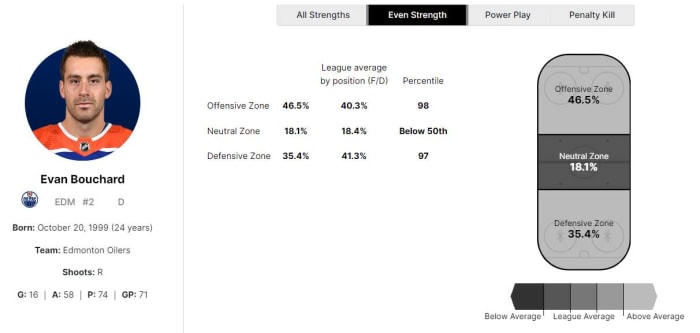
Bouchard has spent nearly 47 percent of his even-strength TOI in the offensive zone, ranking in the 98th percentile in the league. As a result, he has spent just 35 percent of his time in the defensive zone, ranking in the 97th percentile.
The best way to defend is simply not to defend; the more time you spend in the offensive zone, the less time you spend in the defensive zone. The more you have the puck, the less time the opposition has the puck, and the less opportunity they have to generate offence. That does not imply a good offence is a good defence; rather, sustained offensive zone puck possession is a good defence, and Bouchard is a prime example. He excels at holding the blueline, knocking down clearing attempts, and pinching to sustain possession.
These possession metrics are not solely a byproduct of playing next to McDavid. Without McDavid on-ice, Bouchard still holds a fantastic 56 percent shot attempt differential. Bouchard’s relTM (relative to teammates) impact on on-ice shot differential ranks fourth among all NHL defencemen.
There should be no doubt Bouchard is an excellent offensive player in the OZ. But, his ability to sustain OZ possession is also a significant factor in his defensive results.
Neutral Zone (Zone Entries and Entry Defence)
Moving on, let’s first discuss the offensive side of Bouchard’s neutral zone play. Regarding zone entries, Bouchard has not jumped up in the rush as often this season. Averaging 2.9 controlled zone entries per hour, Bouchard does rank above the league-average for defencemen (~2.3), but Kulak, Nurse, and Ekholm rank above him.
This certainly isn’t a bad thing by any means at all; it’s simply not Bouchard’s primary role to carry the puck into the offensive zone with McDavid and Draisaitl on-ice, as Bouchard tends to do more of the heavy lifting with zone exits instead (discussed in more detail later). Still, Bouchard ranks second among the defencemen in controlled entries leading to scoring chances per 60, only behind Kulak. When Bouchard does carry the puck into the zone, he often generates quality shots.
Now, what about the other end of the spectrum? Here is a look at how Edmonton’s defencemen have defended opposition zone entries:
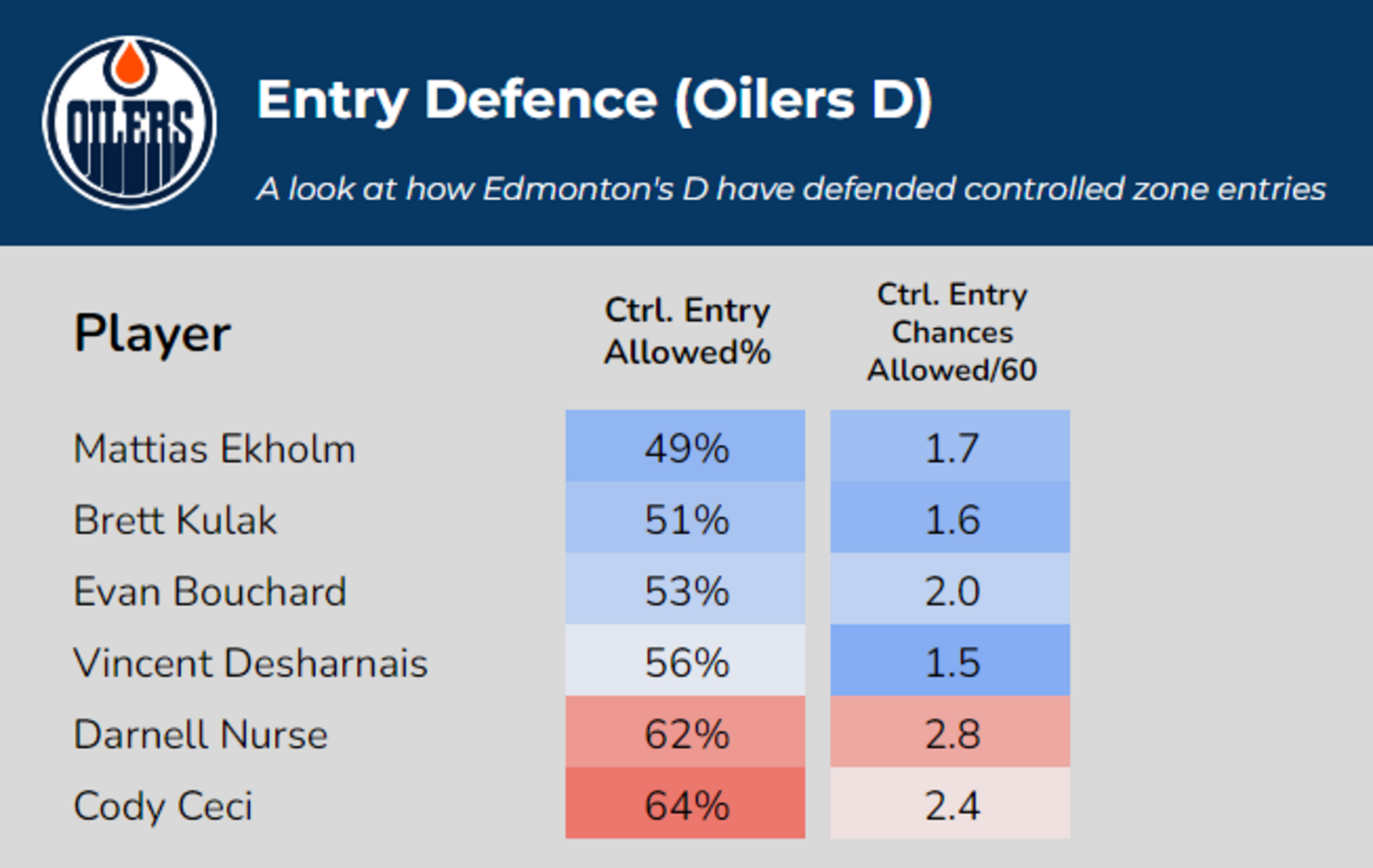
Mattias Ekholm is Edmonton’s best rush defender, while Brett Kulak has strong results in a sheltered role.
Bouchard also ranks well here. He is a much better neutral zone defender than he is given credit for.
Controlled entry allowed percentage measures the total number of entry targets against a defender that resulted in a controlled zone entry; the lower the percentage, the better (league average is ~57-58%). Entry defence is a very important aspect of overall defence, as, on average, a shot off the rush (i.e. a shot off a controlled entry) is more dangerous than a forecheck or cycle shot. Controlled entries are also typically three times more likely to result in a quality chance than dump-ins. Consequently, the best rush defenders consistently pressure opposition players into dumping the puck in, or deny the entry attempt completely.
Bouchard is often aggressive when defending the rush. He’s certainly not afraid to step up the blueline and deny entry attempts, and they often result in transitional opportunities the other way. Even when Bouchard does allow controlled entries, note that Bouchard has played more TOI against elite opposition than any Oiler defender, and yet, he still ranks above the average in terms of the total scoring chances allowed off controlled entries against him. Bouchard’s overall ability to defend 1v1 in transition is an underrated aspect of his game.
Let’s go through some video examples.
In this play, Vegas begins to break out from their zone. William Karlsson attempts to enter the zone, but Bouchard steals the puck from him at the blue line, briefly retreats into his own zone, and then fires an outlet pass resulting in a zone entry for Draisaitl the other way.
Here, Calgary attempts to rush up the ice from their defensive zone, but Bouchard quickly denies the attempt in the neutral zone, and Holloway immediately re-enters the offensive zone to generate a decent rush chance.
This was a game in which Ekholm was out of the lineup due to an illness, and Kulak was in his place on the top pairing. Bouchard stepped up in Ekholm’s absence, allowing just four controlled entries on 10 entry targets and led the team with four zone denials as seen above.
These entry denials aren’t exactly the types of plays you’ll see on highlight reels. They’re not particularly flashy or very noticeable. But, each of them resulted in a failed attempt to generate offence by the opposition, and often an entry attempt for Bouchard’s teammates the other way.
Consistently making these types of plays over a season will consistently result in better defensive and offensive on-ice results. It’s another reason Bouchard spends so much time in the OZ, and so little in his own zone (relatively).
Now, Bouchard is by no means a perfect entry defender. Sometimes, over-aggressiveness at the blueline can cost you. Here’s an example of poor entry defence from Bouchard:
At times, Bouchard can certainly be prone to getting caught high or burned off the rush.
But Bouchard’s overall individual NZ defensive impact is quite good, and it is not just a product of playing next to Ekholm. For even more examples of Bouchard’s entry defence, here’s a compilation of Bouchard’s entry denials from the 2023 playoffs.
Defensive Zone
Where Bouchard excels
For the analysis of Bouchard’s defensive zone play, I would like to split it into two sections. Let’s begin with the “good” in Bouchard’s defensive-zone play.
Firstly, no Oilers defenceman comes close to Bouchard’s effectiveness at exiting the defensive zone with control.
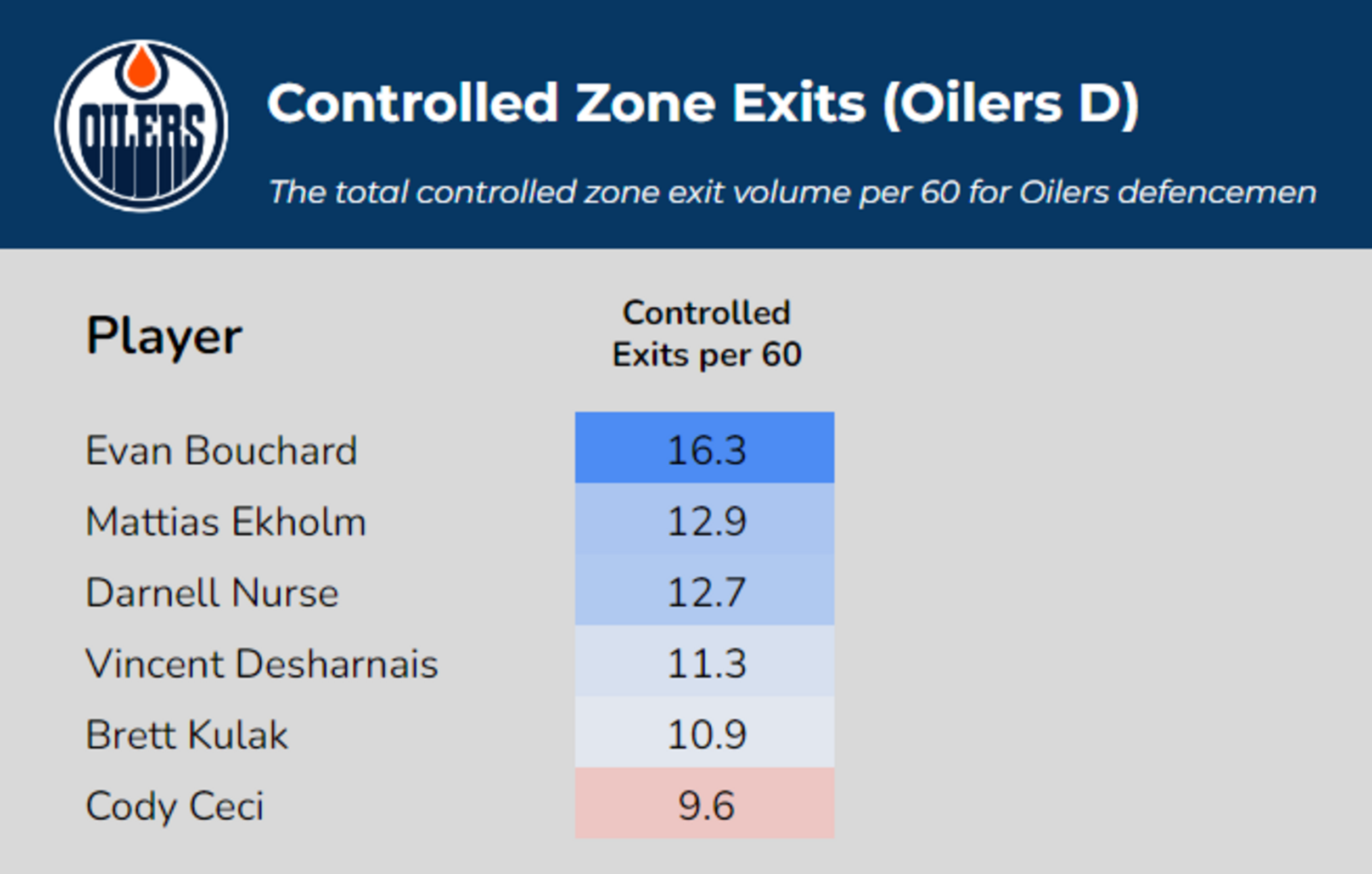
Bouchard averages 16.3 controlled defensive zone exits per 60 minutes of play. No other Oilers defencemen is even above 13.0.
Here is a two-minute compilation of some of Bouchard’s best zone exits this season.
Bouchard is absolutely elite at moving the puck up the ice and transporting it to the forwards. There have been numerous examples of plays this season where a goal or a high-danger scoring chance resulted or began from a crisp outlet pass from Bouchard in the defensive zone.
Once again, zone exits are impactful offensively and defensively; moving the puck up the ice not only grants your teammates an opportunity to generate offence, but it also results in less time spent in your own end. This is an area where Bouchard has dominated.
Moving on, there is one area of the defensive zone where some may believe Bouchard struggles in, but the reality is that he is quite good at it; puck retrievals.
Here’s how Edmonton’s defencemen have fared when retrieving opposition dump-ins:
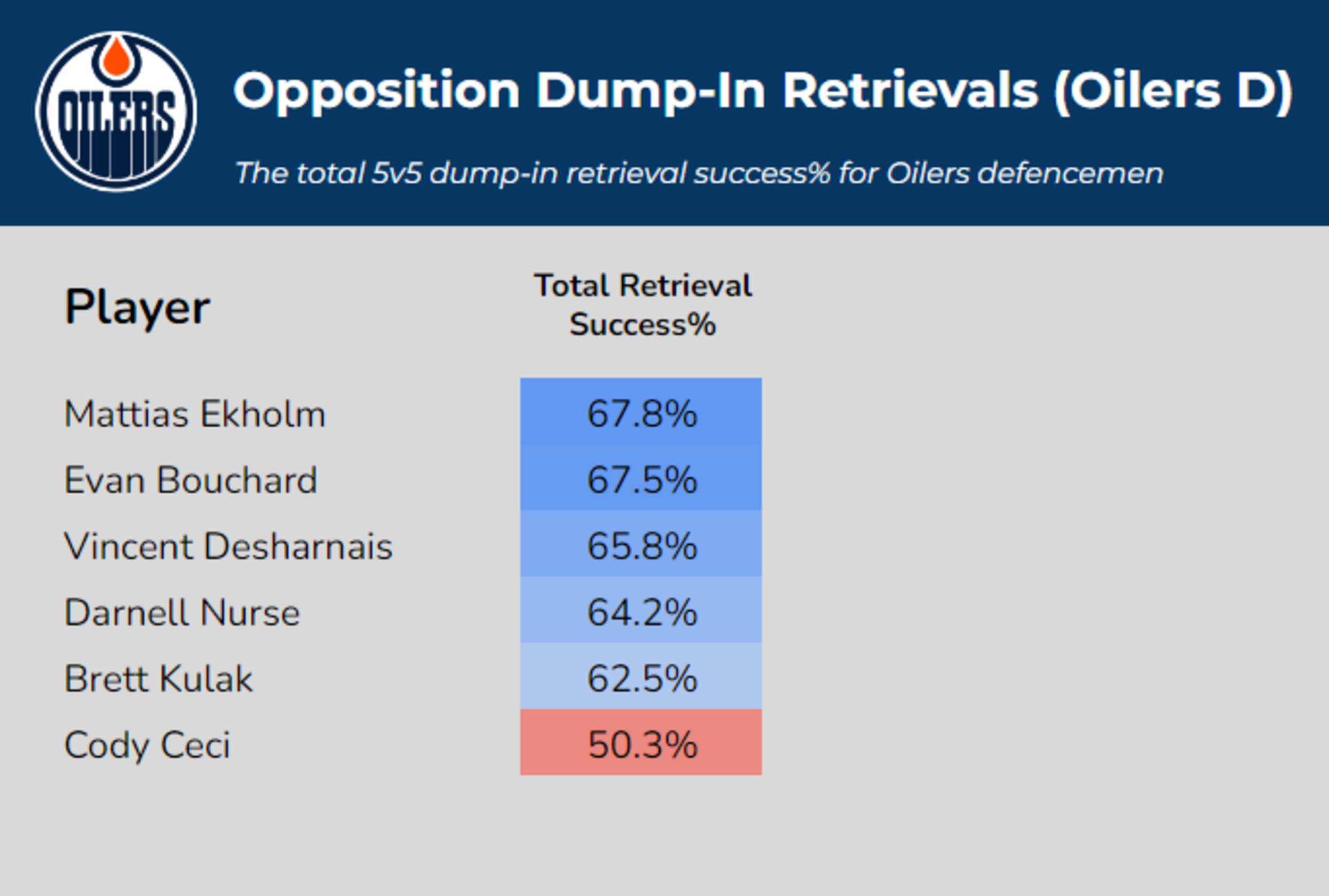
Retrievals have always been an area in which Ekholm has thrived in, and this season, he continues to lead Edmonton’s defensive core in this area – but not by much. Bouchard ranks second among Edmonton’s defencemen in retrieval success rate, and a mere 0.3 percent behind Ekholm.
Let’s go through more video.
The Penguins dump the puck following a missed exit attempt from Ekholm & McDavid. Under pressure from Evgeni Malkin, Bouchard cleanly retrieves a puck, Ekholm exits the zone, and McDavid nearly scores off the rush. This play is a full team effort, but it all begins from a retrieval by Bouchard.
Here’s another instance where Bouchard skillfully retrieves an opposition dump-in, leading to another McDavid zone entry the other way.
On this play, Seattle dumps the puck in, and Bouchard cleanly retrieves it under pressure. Ekholm gives it right back to him, and Bouchard passes it out of the zone, leading to yet another decent rush chance for McDavid and Draisaitl.
Again, these aren’t glamorous or flashy plays, but it’s not easy to consistently retrieve pucks under forecheck pressure from top opposition forwards and move it with control (just ask Cody Ceci). There are massive benefits to retrieving pucks and moving it out of the zone consistently and efficiently, and they reflect in Bouchard’s on-ice results.
Where Bouchard must improve
On the other hand, Bouchard can cut down on his turnovers.
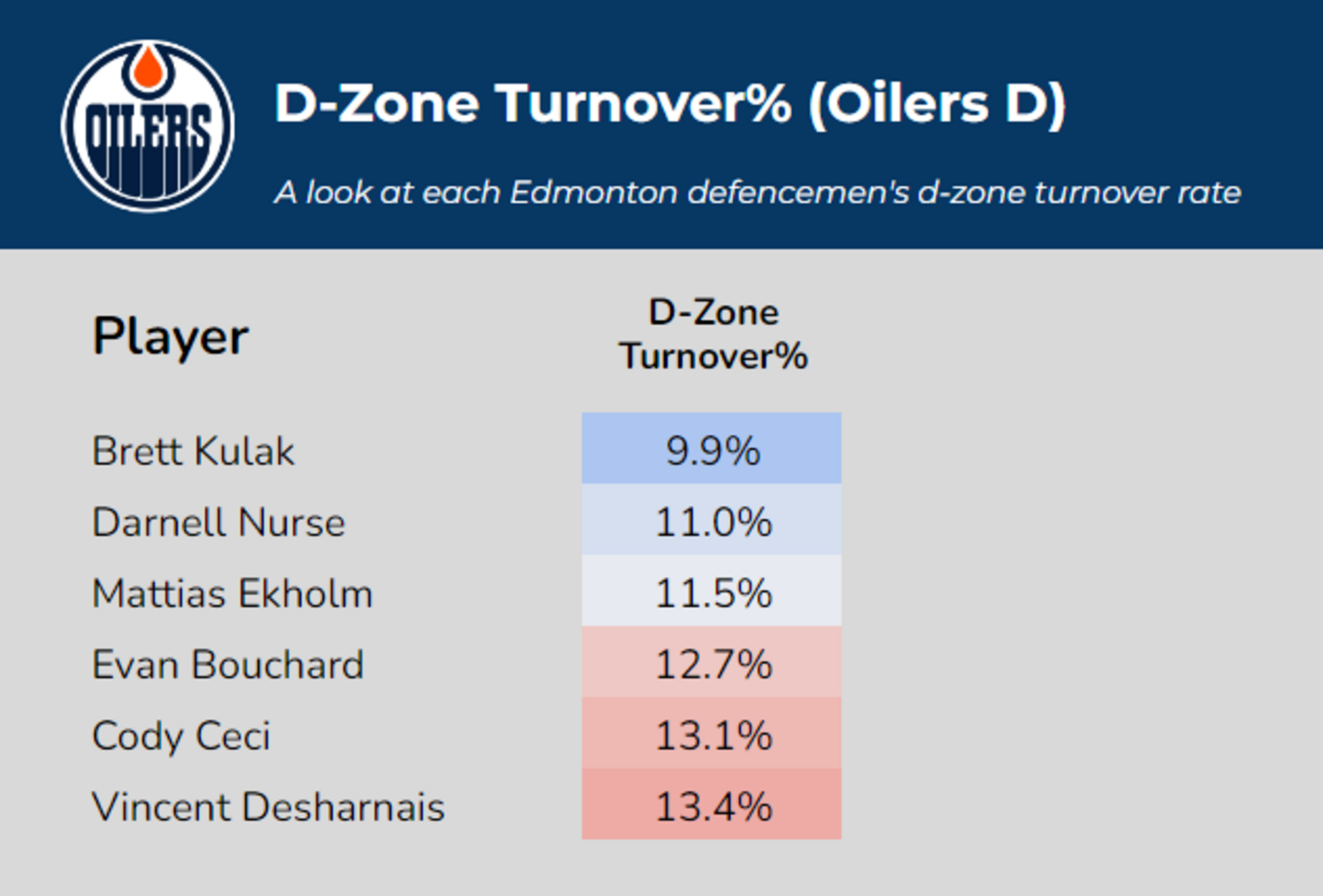
I have always disliked using raw giveaway/turnover metrics, as players that play the puck more will always turn the puck at higher volumes than players that rarely possess the puck. This DZ turnover percentage stat measures the total amount of turnovers relative to the number of the player’s DZ puck touches, which is a much more fair metric in my opinion.
Using this metric, Bouchard is not the massive turnover machine that some claim he is, so I feel this issue can be overblown. He simply moves the puck at high rates, and that can result in a relatively higher volume of turnovers, but his controlled exit to turnover rate still ranks first amongst the defencemen by a hefty margin.
Nonetheless, this is undoubtedly an area where he can improve on, as the average turnover rate is typically around ~12 percent. His turnovers can occasionally lead to quality chances against. If Bouchard can reduce his turnovers and still maintain his controlled exit rate, it’s not an exaggeration to say he could be a top-two puck-mover in the entire NHL.
Now, the biggest issue in Bouchard’s game are the overall mental errors in his own zone. Here’s one glaring example in a game against Florida earlier in the season.
There are also notable examples from the last two weekends, one where Bouchard allowed MacKinnon’s pass on an eventual overtime winning goal from Colorado, and also the error on the GA in the Toronto game linked above. While I do think some of the criticism towards Bouchard in these two specific plays were somewhat overblown (Draisaitl was just at fault for the Lehkonen OT goal, and Bouchard was at the end of a very long shift on the GA against Toronto), there’s no denying that defensive miscues can be prevalent in Bouchard’s game.
Bouchard’s in-zone defending and overall defensive coverage without the puck on his stick is his greatest weakness. There are often plays where he can be slow to recognize danger, and can certainly be prone to getting burned on goals against at times. He has significantly improved in this facet in comparison to the beginning of the season, but this is the area where playing next to a reliable in-zone defender like Ekholm has benefitted him the most.
Final Thoughts
Hockey is a fast game. There are typically ~60+ shots, ~120+ zone entries, ~150+ zone exits, and hundreds of puck touches per team in the average NHL game. It’s impossible to remember and analyze every play in every game throughout the course of an entire season, and as such, our eyes are often biased towards the “flashy” or more noticeable plays. Those are the types of plays we often remember at the end of a game, while we often tend to miss the subtle, effective plays at full game speed.
I believe this is why Bouchard can often be so polarizing.
There are a variety of different things Bouchard does exceedingly well, as touched on in this piece. But, Bouchard can occasionally make glaring mistakes leading to five-alarm chances against, and those are more noticeable and memorable, which is why there can often be so much criticism towards his defensive play. My intention isn’t to excuse his defensive lapses, because he could undoubtedly reduce those types of plays, but to only acknowledge the mistakes and not mention all the positive plays he makes game in and out is simply unfair analysis.
Zone exits, puck retrievals, entry defence, and sustaining possession – these are all key areas of hockey, even if they are not mentioned or noticed as often, and Bouchard excels at them. The types of plays Bouchard makes consistently results in the puck moving in the right direction, causing less time in the defensive zone, and more time in the offensive zone.
There is no doubt Bouchard has benefitted from playing next to McDavid offensively, and Ekholm defensively. However, even without both McDavid and Ekholm on-ice, Bouchard holds a fantastic 60 percent goal differential and a 63 percent expected goal differential this season.
Alongside his excellent offence and production, Bouchard’s defensive impacts this season are much better than given credit for. His impact on preventing even-strength scoring chances against (RAPM xGA/60) ranks in the 64th percentile among all NHL defencemen this season. Statistically, he has been an overall above-average defender this season, largely because of how much time the Oilers spend away from the defensive zone with Bouchard on-ice.
Is Bouchard’s in-zone defending and overall defensive awareness a weakness? Absolutely. But, I think a lot of people tend to hyper-fixate on his errors due to how glaring they can often look. He simply is not some massive defensive liability, and the impact of his offensive and transitional plays significantly outweigh the impact of his occasional errors, an area in which he has improved.
Simply put, Evan Bouchard is the real deal. He is far from perfect, but he remains one of the most talented defencemen this franchise has ever had.
More must-reads:
- Rangers special teams, goaltending help them take control against Hurricanes
- Watch: Overtime goal completes Avalanche's comeback in 4-3 win over Stars
- The 'Leading scorers from the 1992-93 NBA season' quiz
Breaking News
Customize Your Newsletter
 +
+
Get the latest news and rumors, customized to your favorite sports and teams. Emailed daily. Always free!

